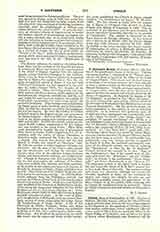

O Salutaris Hostia (O SAVING HOST), the first line of the penultimate stanza of the hymn, “Verbum supernum prodiens”, composed by St. Thomas Aquinas for the Hour of Lauds in the Office of the Feast of Corpus Christi. This stanza and the final stanza, or doxology (Uni trinoque domino), have been selected to form a separate hymn for Benediction of the Most Blessed Sacrament. Usually, and most appropriately, it is begun either when the door of the tabernacle is opened or when the monstrance is being placed on the throne of exposition. In England the singing of the “O Salutaris” is enjoined in the “Ritus servandus”, the code of procedure approved by a former synod of the Province of Westminster (see Benediction of the Blessed Sacrament). But the use of the hymn, not being prescribed in the rubrics, is not of universal obligation. It is, however, very generally used, although any other appropriate text is permissible, such as the “Adoro Te devote”, the “Pange, lingua”, the antiphon “O sacrum convivium” etc. While it is not forbidden to sing vernacular hymns at Benediction the “O Salutaris”, being a liturgical text, cannot be sung in the vernacular (S.R.C., February 27, 1882, Leavenworth. Cf. “Am. Eccl., Rev.”, April, 1895, 341). The hymn is often chosen as a motet for solemn Mass, and may thus be used after the proper Offertory for the day has been sung or recited. An indefensible, but, fortunately, very rare, custom, perhaps inaugurated by Pierre de la Rue, the profound contrapuntal composer of the fifteenth century, was that of replacing the “Benedictus” at Mass by the “O Salutaris”. Gounod imitated his example in his first “Mass of the Orphéonistes”, but in his second mass of that name gives both the “Benedictus” and the “O Salutaris”, as Rossini in his posthumous “Messe Solennelle” and Prince Poniatowski in his “Mass in F”. The plainsong melody in the eighth mode is beautiful, and forms the theme of de la Rue’s musical tour de force in the Mass of that title. The modern settings have been very numerous, although not always serviceable, inasmuch as many are too theatrical for church use; others are entirely for solo use, and still others probably violate the prescription of the Motu Proprio of November 22, 1903, requiring that in hymns the traditional form be preserved. There are about twenty-five poetical versions of the hymn in English.
H. T. HENRY

